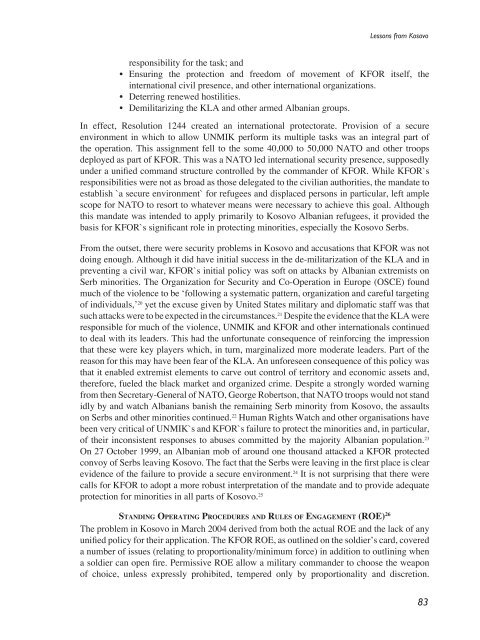Defence Forces Review 2008
Defence Forces Review 2008
Defence Forces Review 2008
You also want an ePaper? Increase the reach of your titles
YUMPU automatically turns print PDFs into web optimized ePapers that Google loves.
Lessons from Kosovo<br />
responsibility for the task; and<br />
• Ensuring the protection and freedom of movement of KFOR itself, the<br />
international civil presence, and other international organizations.<br />
• Deterring renewed hostilities.<br />
• Demilitarizing the KLA and other armed Albanian groups.<br />
In effect, Resolution 1244 created an international protectorate. Provision of a secure<br />
environment in which to allow UNMIK perform its multiple tasks was an integral part of<br />
the operation. This assignment fell to the some 40,000 to 50,000 NATO and other troops<br />
deployed as part of KFOR. This was a NATO led international security presence, supposedly<br />
under a unified command structure controlled by the commander of KFOR. While KFOR`s<br />
responsibilities were not as broad as those delegated to the civilian authorities, the mandate to<br />
establish `a secure environment` for refugees and displaced persons in particular, left ample<br />
scope for NATO to resort to whatever means were necessary to achieve this goal. Although<br />
this mandate was intended to apply primarily to Kosovo Albanian refugees, it provided the<br />
basis for KFOR`s significant role in protecting minorities, especially the Kosovo Serbs.<br />
From the outset, there were security problems in Kosovo and accusations that KFOR was not<br />
doing enough. Although it did have initial success in the de-militarization of the KLA and in<br />
preventing a civil war, KFOR`s initial policy was soft on attacks by Albanian extremists on<br />
Serb minorities. The Organization for Security and Co-Operation in Europe (OSCE) found<br />
much of the violence to be ‘following a systematic pattern, organization and careful targeting<br />
of individuals,’ 20 yet the excuse given by United States military and diplomatic staff was that<br />
such attacks were to be expected in the circumstances. 21 Despite the evidence that the KLA were<br />
responsible for much of the violence, UNMIK and KFOR and other internationals continued<br />
to deal with its leaders. This had the unfortunate consequence of reinforcing the impression<br />
that these were key players which, in turn, marginalized more moderate leaders. Part of the<br />
reason for this may have been fear of the KLA. An unforeseen consequence of this policy was<br />
that it enabled extremist elements to carve out control of territory and economic assets and,<br />
therefore, fueled the black market and organized crime. Despite a strongly worded warning<br />
from then Secretary-General of NATO, George Robertson, that NATO troops would not stand<br />
idly by and watch Albanians banish the remaining Serb minority from Kosovo, the assaults<br />
on Serbs and other minorities continued. 22 Human Rights Watch and other organisations have<br />
been very critical of UNMIK`s and KFOR`s failure to protect the minorities and, in particular,<br />
of their inconsistent responses to abuses committed by the majority Albanian population. 23<br />
On 27 October 1999, an Albanian mob of around one thousand attacked a KFOR protected<br />
convoy of Serbs leaving Kosovo. The fact that the Serbs were leaving in the first place is clear<br />
evidence of the failure to provide a secure environment. 24 It is not surprising that there were<br />
calls for KFOR to adopt a more robust interpretation of the mandate and to provide adequate<br />
protection for minorities in all parts of Kosovo. 25<br />
St a n d i n g Op e r a t i n g Pr o c e d u r e s a n d Ru l e s o f En g a g e m e n t (ROE) 26<br />
The problem in Kosovo in March 2004 derived from both the actual ROE and the lack of any<br />
unified policy for their application. The KFOR ROE, as outlined on the soldier’s card, covered<br />
a number of issues (relating to proportionality/minimum force) in addition to outlining when<br />
a soldier can open fire. Permissive ROE allow a military commander to choose the weapon<br />
of choice, unless expressly prohibited, tempered only by proportionality and discretion.<br />
83
















